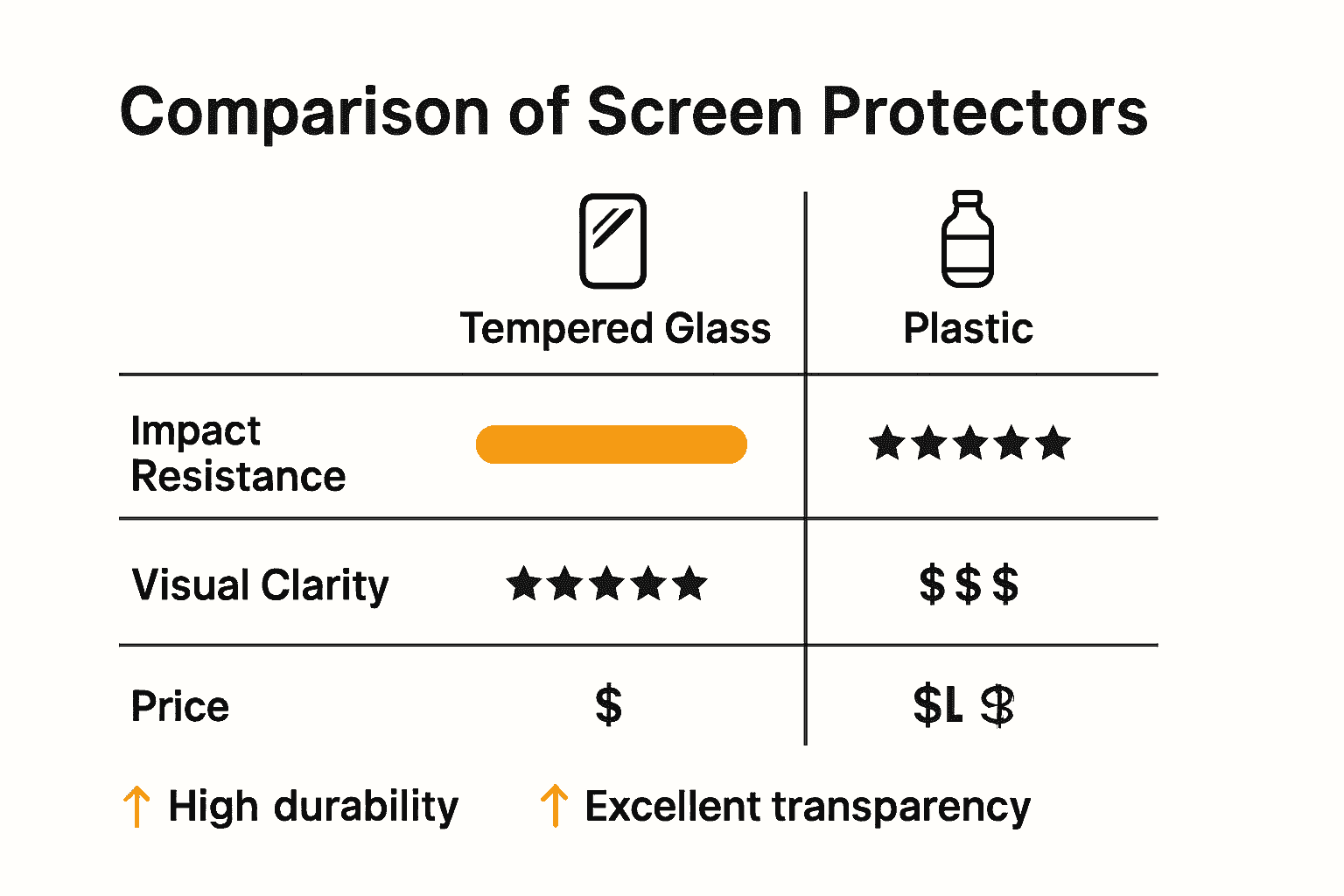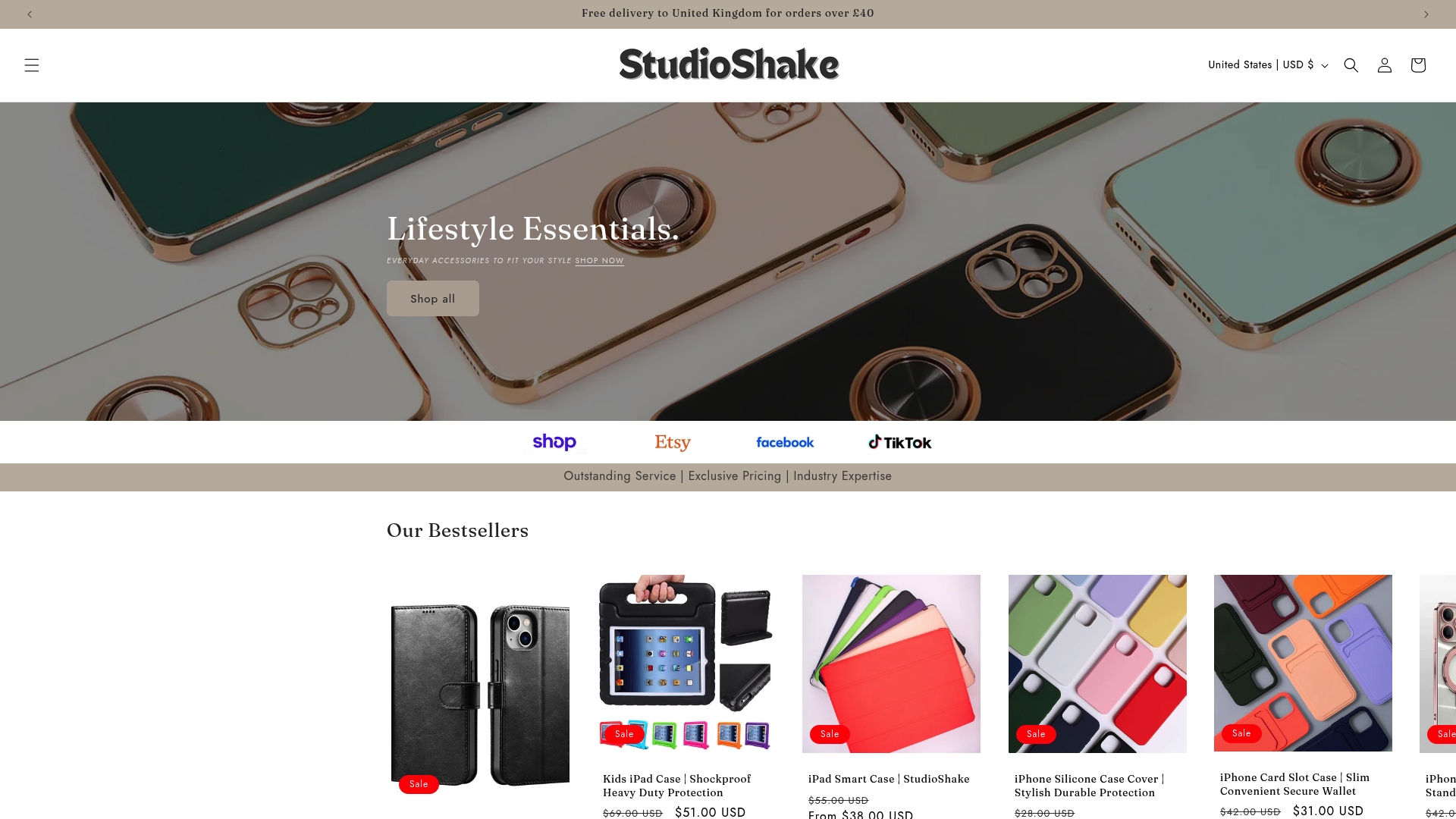
Complete Guide to Why Use Tempered Glass
Share
Glass can be surprisingly tough when science gets involved. Tempered glass is not just ordinary glass made strong—it can be up to five times stronger than standard glass. With this power, it stands up to heavy impacts and guards against sharp shards that cause injuries. Understanding how tempered glass works gives anyone the upper hand in choosing safer, smarter products for homes, devices, and everyday life.
Table of Contents
- What Is Tempered Glass? Core Properties Explained
- Types of Tempered Glass for Devices
- How Tempered Glass Protects Your Phone
- Safety Standards and UK Regulations for Tempered Glass
- Comparing Tempered Glass With Other Screen Protectors
Key Takeaways
| Point | Details |
|---|---|
| Enhanced Strength | Tempered glass is four to five times stronger than standard glass due to thermal treatments, making it ideal for safety-critical applications. |
| Safety Features | Upon breaking, tempered glass shatters into small, less harmful pieces, significantly reducing injury risks. |
| Screen Protection | Tempered glass protectors absorb impacts and scratches, preserving the functionality and appearance of electronic devices. |
| Regulatory Standards | In the UK, tempered glass must meet stringent safety standards, ensuring consistent performance and consumer protection across various applications. |
What Is Tempered Glass? Core Properties Explained
Tempered glass represents a technological marvel in materials engineering, transforming ordinary glass into an extraordinarily robust protective substance. According to Ingenia, this specialised glass undergoes a remarkable transformation through thermal treatments that fundamentally alter its structural integrity.
The production process involves heating standard glass to approximately 620°C and then rapidly cooling it - a technique that induces unique internal stresses. These precise thermal manipulations create compressive surface stresses and internal tensile stresses, which dramatically enhance the glass’s strength. As a result, tempered glass becomes four to five times stronger than traditional annealed glass, making it significantly more durable and resistant to impacts.
When subjected to extreme force, tempered glass demonstrates an extraordinary safety feature: instead of breaking into large, dangerous shards, it shatters into small, relatively harmless granular chunks. This characteristic reduces injury risks substantially, which is why PAT notes its widespread application in environments prioritising safety and durability. The glass’s properties make it ideal for numerous applications, including:
- Automotive windows
- Electronic device screens
- Building facades
- Kitchen appliances
- High-traffic architectural elements
Beyond its strength, tempered glass offers additional practical advantages. Its smooth, non-porous surface facilitates easy cleaning, and it demonstrates remarkable resistance to high temperatures without warping or discoloration. These qualities make it an exceptional choice for environments requiring both aesthetic appeal and functional resilience.

Learn more about tempered glass protectors in our comprehensive guide.
Types of Tempered Glass for Devices
Tempered glass has evolved significantly in device protection, offering multiple sophisticated manufacturing techniques to enhance durability and performance. According to Ingenia, there are primarily two fundamental approaches to creating strengthened glass for electronic devices: thermal tempering and chemical strengthening.
Thermal Tempered Glass represents the traditional method of glass strengthening. This technique involves heating glass to extremely high temperatures (around 620°C) and then rapidly cooling it, creating intense surface compression. The rapid cooling process generates significant internal stresses that make the glass substantially more resistant to impacts and structural damage. Devices like smartphones, tablets, and wearable technology frequently utilise this type of tempered glass for screen protection.
Chemically Strengthened Glass offers an advanced alternative with even greater durability. Ingenia explains that this method uses ion exchange, where smaller sodium ions are replaced with larger potassium ions. This molecular transformation creates compressive stress throughout the glass, resulting in superior scratch resistance and structural integrity. Chemically strengthened glass is particularly prevalent in high-end electronic devices requiring maximum protection.
The key differences between these types of tempered glass include:
-
Thermal Tempered Glass
- Lower cost of production
- Good general impact resistance
- Suitable for standard device screens
-
Chemically Strengthened Glass
- Higher production costs
- Superior scratch and impact resistance
- Ideal for premium devices
When selecting a tempered glass protector, understanding these variations helps consumers make informed choices about device protection. Explore our comprehensive guide to device screen protectors to learn more about finding the right protection for your specific device.
How Tempered Glass Protects Your Phone
Protecting your smartphone’s screen is more than just a precautionary measure - it’s a crucial investment in your device’s longevity and performance. According to Ingenia, tempered glass provides an exceptional layer of defence by creating a robust barrier that absorbs impacts and resists everyday wear and tear.
Impact Absorption is the primary mechanism of protection. The unique manufacturing process induces compressive stresses on the glass surface, dramatically enhancing its strength. When your phone experiences a sudden drop or collision, the tempered glass screen protector acts as a sacrificial layer, absorbing the shock and preventing damage to the underlying original screen. PAT highlights that this approach allows the protector to withstand drops and impacts that would easily crack or shatter a standard glass screen.
Beyond physical protection, tempered glass offers additional benefits that preserve your phone’s functionality and appearance:
- Scratch Resistance: Prevents microscopic scratches from keys, coins, and daily handling
- Clarity Preservation: Maintains screen responsiveness and visual quality
- Stain Resistance: Smooth, non-porous surface repels oils and fingerprints
- Easy Replacement: Much cheaper to replace a screen protector than a phone screen
The safety features are particularly impressive. When subjected to extreme force, tempered glass shatters into small, relatively harmless pieces instead of large, dangerous shards. This design significantly reduces the risk of injury and prevents glass fragments from damaging your phone’s internal components.
Learn more about comprehensive phone screen protection strategies to keep your device safe and looking pristine.
Safety Standards and UK Regulations for Tempered Glass
Navigating the complex landscape of safety standards for tempered glass requires understanding the critical regulations that protect consumers and ensure product quality. According to ESG, the UK has established rigorous standards to guarantee the safety and performance of tempered glass across various applications.
BS EN 12150 stands as the cornerstone of tempered glass safety regulations in the United Kingdom. This comprehensive standard specifies exacting requirements for thermally toughened soda lime silicate safety glass, covering crucial aspects such as:
- Mechanical strength benchmarks
- Precise fracture characteristics
- Thermal resistance capabilities
- Performance under temperature differentials
Ingenia emphasises that this standard is not merely a bureaucratic exercise, but a critical framework ensuring glass used in safety-critical applications meets stringent quality criteria. The regulations apply across diverse sectors, including:
- Automotive windows
- Electronic device screens
- Building facades
- Public infrastructure
The regulatory framework goes beyond simple manufacturing guidelines. It represents a comprehensive approach to consumer safety, mandating that tempered glass must demonstrate consistent performance under various stress conditions. Manufacturers must subject their products to rigorous testing, ensuring that when tempered glass encounters extreme conditions, it fractures in a predictable, controlled manner that minimises potential injury risks.
Learn more about phone case durability and protection standards to understand how these regulations impact device safety.
Comparing Tempered Glass With Other Screen Protectors
Choosing the right screen protector can be a minefield of technical specifications and competing claims. According to Ingenia, tempered glass stands out as a superior option with significant advantages over traditional screen protection alternatives.
Plastic Screen Protectors represent the most common alternative, but they fall short in several critical areas. Tempered glass offers substantially better protection through its unique manufacturing process. PAT highlights that tempered glass is several times stronger than traditional protective materials, providing enhanced durability and safety.
Key comparison points between screen protector types include:
-
Tempered Glass
- Superior impact resistance
- Maintains original screen feel
- Crystal-clear optical clarity
- Smoother touch experience
-
Plastic Protectors
- Lower impact protection
- Can feel less responsive
- More prone to scratching
- Cheaper initial cost
The most significant differences emerge in real-world usage. Tempered glass protectors closely mimic the original screen’s touch sensitivity and visual quality, creating an almost imperceptible layer of protection. They absorb impacts more effectively, potentially saving your device from costly screen replacements. The manufacturing process creates a protective layer that’s not just a barrier, but a genuine enhancement to your device’s screen.

Learn more about the comprehensive role of screen protectors to make an informed protection choice.
Protect Your Devices with Premium Tempered Glass Solutions
Understanding the remarkable strength and safety benefits of tempered glass can alleviate worries about cracked screens and costly repairs. The article highlights pain points such as vulnerability to impact, scratches, and the need for a reliable sacrificial layer to absorb shocks. With terms like compressive surface stresses and impact absorption emphasising the science behind tempered glass, it is clear that quality protection matters deeply for your everyday devices.
Explore our extensive range of phone cases and screen protectors at StudioShake designed to harness these protective properties.

Don’t leave your phone exposed to risk when you can benefit from advanced tempered glass technology that combines durability, clarity, and safety. Visit our guide to device screen protectors to make an informed choice and discover how to safeguard your device today. Experience hassle-free protection with our trusted accessories by starting here at StudioShake. Protect your investment before accidents happen.
Frequently Asked Questions
What is tempered glass and how is it made?
Tempered glass is a type of safety glass that is made by heating standard glass to approximately 620°C and then rapidly cooling it. This process creates unique internal stresses that enhance the glass’s strength, making it four to five times stronger than traditional glass.
What are the benefits of using tempered glass as a screen protector?
Tempered glass offers superior impact resistance, scratch protection, and clarity preservation. It absorbs shocks from drops and prevents damage to the underlying screen, while its smooth surface is easy to clean and maintains screen responsiveness.
How does tempered glass compare to plastic screen protectors?
Tempered glass is significantly stronger than plastic screen protectors, providing better impact resistance and clarity. It also closely mimics the original screen’s feel and touch responsiveness, whereas plastic protectors can sometimes feel less responsive and are more prone to scratches.
What safety standards govern the use of tempered glass?
In the UK, tempered glass must meet the BS EN 12150 standard, which includes requirements for mechanical strength, fracture characteristics, and thermal resistance. This ensures that the glass performs reliably under stress and minimizes injury risks when broken.
